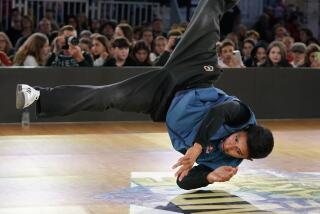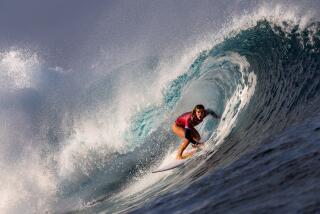Surfing Goes Long : Return of Longboards Brings New Wave of Riders
- Share via
HUNTINGTON BEACH — Back in 1988, a rebellious Dave Parmenter paddled out for his heat at the Op Pro surfing championships on a longboard, prompting laughter from contest judges and the fans on the beach.
Who was Parmenter kidding?
No way could someone riding a heavy 9 1/2-foot longboard compete against the sharp-cutting, six-foot shortboards at the prestigious Op Pro.
Parmenter couldn’t keep up, losing his heat by several points to Australia’s Richard Marsh.
But afterward, Parmenter claimed victory by sending a message to the surfing world that day at the Huntington Beach Pier.
“I did it in protest of the flapping, kicking and waving of paddling gloves that is being bred into modern (shortboard) surfers,” he said.
Somebody must have been listening.
Six years after Parmenter’s off-the-cuff protest, longboard riding has attracted a new wave of surfers, both young and old, to competitions such as the U.S. Open, which started Tuesday at the pier.
Gone are the 50-pound redwood longboards surfers rode in the 1950s and early ‘60s. Technology has produced lightweight foam and fiberglass boards that allow surfers to duplicate shortboard maneuvers without sacrificing traditional longboard moves such as noserides.
As a result, the faster, lighter longboards have brought the baby boomers back to the beach . . . and they’re bringing their kids with them.
“We’re just starting to see the first generation of kids riding longboards,” said Corky Carroll, an Orange County surfing legend and U.S. longboard champion in the 1960s.
“The guys like Joel Tudor and Joey Hawkins are the first group to start riding the (newer) longboards. For years it was my generation that dominated the longboard contests. Now there’s a whole new group, and they’re really, really good.”
Tudor, an 18-year-old from San Diego, won the Op Pro longboard contest Sunday at the pier. He’s among 70 longboard surfers, ages 17 to 55, competing with veterans such as Carroll and David Nuuhiwa today at the U.S. Open, which also features divisions for shortboard riders, bodyboarders and women.
Even some pro shortboard surfers are giving longboards a try this week. San Clemente’s Dino Andino and Shane Beschen, Chris Frohoff of Redondo Beach and Ted Robinson of Manhattan Beach are entered in the longboard event.
But the renewed interest in longboard riding stretches far beyond the pro surf contests.
Mike Kingsbury, spokesman for the Surf Industry Manufacturers Assn., said an estimated 1.5 million people in the United States surf, and participation in the sport has grown at a rate of 10% a year. Longboard sales have increased 20% a year during the last two years, he said.
Carroll, who manages Wind N Sea surfboards in Huntington Beach, said he sells “50 longboards for every one shortboard.”
“If you are over 20 years old and you don’t surf everyday,” he said, “you need a longboard to surf in smaller waves. All the 17- or 18-year-old kids who are out there all the time control the (larger-wave) lineup with shortboards.”
Surfers abandoned the longboard in the late 1960s for the new, sleek shortboards that were easier to maneuver. As technology improved over the years, shortboards became lighter, faster and more adaptable to constantly changing wave conditions.
“I was one of the first guys to have a shortboard,” Carroll said. “They were out on the market by 1968, and longboards were just dead for the next several years.”
That decline in popularity ultimately created a generation gap in the surfing world.
Traditionalists rode longboards; their kids were hoping for a shortboard under the tree on Christmas Day.
After all, who wants to ride a longboard that your old man was cruising around on every weekend? Kids’ taste in surfboards was like their taste in cars: Why drive an Impala when you could have a Camaro?
They wanted something fast, something fun. They needed a shortboard.
Over the years, longboard surfers were stereotyped as old men with beer guts hanging over their canvas shorts, slowly paddling into the waves and causing a hazard for shortboard riders.
Robert “Wingnut” Weaver was one of the twentysomething surfers who bridged that generation gap. He grew up in Newport Beach riding longboards while his friends surfed shortboards.
Weaver’s longboard riding skills eventually landed him a part in filmmaker Bruce Brown’s “The Endless Summer II,” a sequel to Brown’s 1964 classic.
Weaver, 28, always rode a longboard, refusing to try the shorter version. He considers himself a surfing purist, a link from the legends who rode the longboard before him to the kids he hopes will ride it in the future.
“The whole style of longboarding appealed to me,” he said. “It was a different approach to surfing, and I had always been into the 1950s and ‘60s. And surfing just captured that era so well.”
Robert August, who starred in the original “Endless Summer,” owns a Huntington Beach surf shop and shaped the 25 longboards Weaver used in the movie.
“Wingnut was the first of the young guys to really dedicate himself to riding the longboard,” August said. “Before him, it was mainly older guys like me riding them. Now, younger kids are finding that you can have fun on them when the waves are three-feet high and mushy.”
It wasn’t until the late 1980s that longboards went on a crash diet, dropping from 50 pounds to 11 and 12. Longboard shapers traded the redwood models and heavy balsa-wood boards for lightweight foam covered with a single layer of fiberglass and stylish designs.
“It’s like anything else,” Carroll said. “As time goes along, there is progress and improvements in a product. That’s what happened with longboards. It’s like a long chain--we had to build it in links.”
Carroll said the longboards he sells are six inches shorter than the boards he rode in the 1960s. A new longboard sells for about $500, about $100 to $200 more than a custom shortboard.
But surfers say the new longboards are worth the price. The boards are custom-built and the lightweight foam allows riders to pull 360-degree turns and ride “floaters” over the top of the wave, just like shortboard riders do. Those moves were impossible with the old, heavy boards.
The newer boards also easier to store, load and carry to the beach. Carroll remembers getting a workout just lugging his old, heavy boards to the pier.
“When I started surfing, the first longboard I rode weighed about 50 pounds,” he said. “And I weighed only about 40 pounds.”
Carroll rides a lightweight board now, trying to keep up with a younger generation at a surf break he once dominated.
He knows the rebirth of longboard riding has been slow, and the sport still has a long way to go before it catches shortboards in popularity.
Prize money and endorsements for longboarders are only a fraction of the hundreds of thousands of dollars that top shortboard riders such as Kelly Slater earn each year.
But Carroll sees a promising future for the sport.
“It’s amazing,” he said “I watched all of the Op contest last week and the longboard competition seemed to be more interesting.
“You saw the final day. The crowd seemed to show more interest in longboarding. I think there’s just a lot of appeal with it because anybody at any age can do it.”


